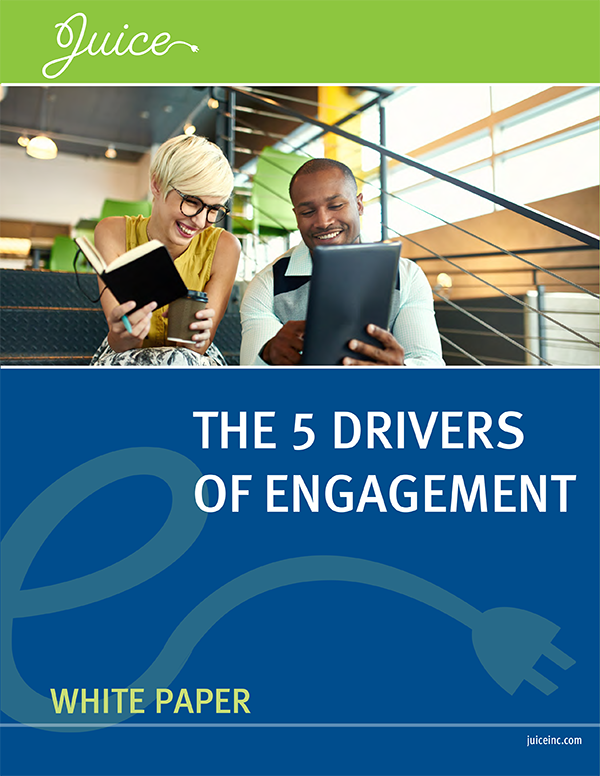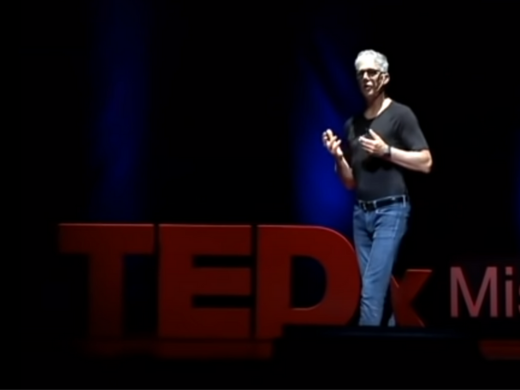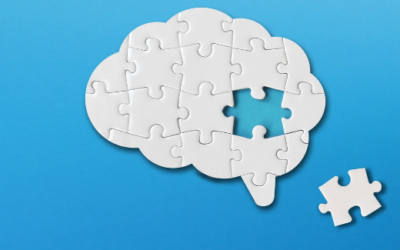
TEDx Talk: How to Fix the Exhausted Brain
Powerful Ideas to Transform Employee Engagement
With an energized brain you can focus your attention. You can regulate your emotions, you can connect the dots in surprising ways. You can anticipate the downstream implications of any decision or behaviour and you can make really smart decisions. But when your brain becomes depleted, you lose access to your executive function.
Across North America, massive amounts of employees, managers and leaders are engaged, but exhausted – they’re dedicated, but depleted.It’s very difficult to bring our best best selves to work when our brain is depleted. Take a moment to listen to Brady Wilson, founder of Juice Inc., as he explains understand why this happens, and how to fix it.
How to fix the exhausted brain
Employees, managers and leaders are engaged, but exhausted. They’re dedicated, but depleted. When your needs are fulfilled at work, energy is the natural byproduct. It makes your brain smarter and your body more vital. Our team exists to help you energize work so that your people feel connected, clear, creative, confident and purposeful.

WHITE PAPER
The Five Drivers of Engagement
What drives engagement in employees? How are emotions connected to productivity and performance? What role can managers play in encouraging and engaging their staff?
In this white paper, Juice identifies the five core drivers that determine employee engagement. Years of testing and scientific validation prove that the these Five Drivers are emotion-based, and that what matters most to employees more than anything else at work is how they feel.
Transcript: Brady Wilson, Juice co-founder, speaks to TEDx Mississauga
I am definitely not the hero of this talk. But if I do my job properly, you will be. You’ll be the hero that goes on a journey today and discovers a gift that could change your world.
First, let me tell you a story that will give you context for everything I’m about to share with you.
I was nine years old. And I was horror stricken. As I watched my two older brothers, Perry and Mark in a vicious fight. They were strangling each other on the floor. My nine year old brain actually believed that I was about to lose one, or maybe both of my brothers. When it was all done, they vowed that they would never speak to each other again.
And they didn’t for several years.
So here’s how it went down in my house, the phone would ring and Perry would answer it and discover that it was for Mark. He would say to me, “Go tell your brother Paul wants to talk to him.” I was drawn into the space between for years.
Fast forward, my brother Mark got into trouble. My dad kicked him out of the house, and held the hard line. Even though my mother’s heart was breaking, she would secretly bake cinnamon buns and come to me and say, “Would you take these to your brother and tell him that I love him?” I was drawn into the space between.
That was 50 years ago, and I have lived in and have worked in the space between ever since. What I want to do today is to help you understand the power of what can happen when we step into that space.
In order to do that, I’m going to share a true and remarkable story with you about Paula and her manager Ziad in which they go on a journey from depleted brains to very energized brains.
So I’d like you to meet Paula. Paula started her job like most of us do, wanting to be a high performer, she was highly engaged and wanted to contribute to the organization. But what happened in her company was there was a reorg. And leaders took their eye off the ball, leaving Paula without the support, guidance, and coaching that she’d so desperately needed. And although Paula had started out engaged, she became exhausted. Although she had started out dedicated, her brain became depleted.
And here’s what we are seeing across North America – massive amounts of employees, managers and leaders who are engaged, but exhausted; they’re dedicated, but depleted. So it’s very difficult to become our best selves when our brain is depleted.
But why is that? Let’s take a moment and peek inside this three pound blob of tofu that nestles into your cranium and understand why that is. This brain of ours, it only comprises 2% of our body weight. But how much energy does it burn every day? It is metabolically expensive. It burns 20% of our energy reserves every single day, far more than any other organ in our body, heart, lungs, liver. They’re all important, but they can’t come close to the energy draw that the brain does. So what happens if you are engaged but exhausted, if you are dedicated but depleted? You will lose access to one very important thing. And the first thing you lose access to is your executive function. So all the autonomic functions of the brain that control your immune system, your digestive system, your fight and flight mechanism, they keep running. But the first thing you lose access to the executive function because the body is very judicious in its use of fuel.
So the executive function, what is it? Well, let’s take a look here. With an energized brain you can focus your attention. You can regulate your emotions, you can connect the dots in surprising ways. You can anticipate the downstream implications of any decision or behavior and you can make really smart decisions. But when your brain becomes depleted and you lose access to the executive function, you get easily distracted.
You can react very impulsively, impulsively, you lose the thread, you fail to see the downstream implications, and you make really unwise decisions. This is not a bad person. This is just a person with a depleted brain.
So this is where Ziad enters the story. In the reorg he became Paula’s new manager, and he sat down with her. And after hearing a few things from other leaders and other managers, in which they said when she’s on her game, Paula is amazing, she’s bright, and she can be highly productive. But she’s begun to struggle with stress and sickness and absenteeism. And in fact, she became absent so often that leaders had seriously considered freeing up her future.
Ziad sat down with Paula and said, “I don’t need to know what’s happening in your personal life. That’s not my business. But I do want you to know that I’m in your corner, that I’ve got your back. So what can we do to take some stuff off your plate to make this work for you?”
Does the approach sound okay, so far?
It’s not okay, so far. It’s actually a train wreck.
My biggest work with leaders is helping them switch and shift from parenting to partnering. Ziad is taking a classic parenting approach, assuming that he knows best and trying to fix Paula’s situation by taking stuff off her plate. And sometimes when people try to fix us, it actually creates more frustration and more depletion.
Every time they had that type of conversation. It was deeply unfulfilling, as both of them walked away. It was in this time period that Ziad happened to come to one of my sessions around energizing people’s brains. And he learned that it’s not magic. In fact, it’s not something you’re either born with, or not. It’s a trainable skill. Anyone can learn how to do it. It’s all about understanding what matters most and connecting on what matters most.
Ziad learned that in any situation, there are things that matter most to us. So for instance, in some situations, belonging, inclusion, acceptance, feeling part of the tribe, social relationships, that is the thing that is deeply energizing for our brains. But there are other situations where we feel a little bit off balance, and security is the thing. So systems structures, consistency rules, and fair play. In other situations, it’s all about freedom. It’s all about autonomy and independence, the ability to get our fingerprints on things, take a risk and make decisions. But in other situations, it is all about significance. The ability to do quality and excellent work, make progress, achieve great results, move the needle. And in some situations, it is all about meaning, purpose, legacy, the greater good changing the world.
It’s very important to understand and connect on what matters most to the person in the specific situation that they are in. Ziad came into this. And what mattered most to him in this situation was freedom. He needed to get free of hand holding a problem employee. And so he assumed that freedom must be the thing that mattered most to Paula as well. So his approach was, “How do we take stuff off your plate? How do we free up mind space for you? Because I know this is stressful for you.”
As I said, what happened was deeply unfulfilling for both of them. What he learned was that for Paula, significance was the deal. And here’s how we learned that.
You don’t have to be a mind reader. You don’t have to be a therapist. You don’t have to be an expert coach to find out what matters to another person. In fact, the people who are best at it do one simple thing. They ask what’s most important to you in this situation?
So Ziad came back from that training session, had a simple conversation with Paula and said, “Paula. This has been difficult. I’m wondering if you know I could do a redo of some of our conversations because I know they’ve been frustrating. I want to ask you one question, what matters most to you in this situation?”
Her response was instant. She said, “I want to be seen as a high performer. I want to be seen as somebody who is highly productive. But every time I meet with you, you take stuff off my plate, you take challenges away from me, you take learning opportunities away from me, I want more challenges at work.”
And Ziad is thinking, who would have thought that somebody who was struggling with stress and sickness and absenteeism wants more challenge at work? He didn’t know if he could really step up and do it. But he thought, let’s give it a go. He started giving her challenge after challenge and coming alongside her and helping her out.
What happened was, every time he did, she stepped up, and she hit it out of the park. Well, when you start to understand what matters most possibility, very fluidly flows from that. He started to see new ways of Paula adding value and stepping in and being innovative. And when that starts to happen, it’s very natural to move into partnering together for progress.
So what was happening inside the brains of our two journeyers here? What was happening was there were some powerful high performance hormones that were flowing. Thanks to the work of Dr. Loretta Bruning, and the Mammal Institute, we know what happens inside the minds of mammals when you put them in certain situations.
For instance, you see the mother and her cub, there is a powerful hormone that is ritually flowing in this situation. Some of you know what it is. It’s oxytocin, not to be confused with oxycontin. When you create connection between two mammals, and we’re mammals, so we can learn from this connection releases oxytocin. Well, who cares about oxytocin? Oxytocin when it’s present in our brain produces a sense of trust, rapport, and bonding. Some of you are thinking, yeah, there are people in my world that I could use more trust with. Is there something you can do that creates connection and unlocks oxytocin inside the brain? There absolutely is.
What does she see? Anybody? What does she see? You can tell by her body language? What is that? She sees food, she sees lunch. When a mammal senses possibility, dopamine is released in our brains. And when dopamine is released, something powerful happens. Motivation, creativity, ingenuity, innovation, goal orientation.
If you know somebody who is unmotivated, the first place their therapist will look is their dopamine levels. Is there something you can do that’s a benevolent brain hack that will release dopamine inside another person? Absolutely. Helping them see a glimmer of possibility, of potential, of opportunity. Mammals love to outdo each other. It guarantees the survival of our species. We feel intensely pleasurable when we make progress, when we have an achievement, when people value and respect us.
Why do we feel so pleasurable? Because serotonin is flowing in our brain. And when serotonin flows in our brain, we feel invincible. It unlocks a sense of agency, belief, confidence, self efficacy, is there something you can do that can unlock that inside another person’s brain absolutely is partnering with them for progress. Now, anybody can connect on what matters most, anyone can help someone see possibility. Anyone can partner for progress.
Why don’t we do it? The surprising reason we don’t do it is not because we’re bored in their presence. It’s not because we’re tethered to our devices; we are. But here’s the big reason. You put yourself in other shoes. And you’re going, aren’t we supposed to do that? Let me tell you, when you put yourself in someone else’s shoes with all of your assumptions, your judgments, your conclusions, your beliefs here’s how the narrative goes. If I were in your shoes, and what comes out next is your autobiographical fix for their situation.
This happened to me powerfully several years ago. My third child Tyler was finishing up University in the East Coast. I was sitting, seated in my dining room and I got the phone call that every parent dreads. Now, the story turns out well, but it was chilling in the moment. He began to describe the situation. We’re in the hospital. We’re going to make it through, but it’s been tough. And he described the vehicle and only keep this slide on for a moment. But the vehicle had rolled several times.
When it landed, it caught on fire. Four of them had been able to get out of the vehicle, but his best friend Holly had been stuck in the front seat and the door was jammed. She was able to extricate herself from the vehicle, they grabbed hold of her, and they got far enough away that when the vehicle blew up, none of them lost their lives. I sat there with unbelievable gratitude on that day that my son Tyler and his four friends had lived through this. We all know it doesn’t always happen that way. Better move it to the next slide. There’s my son Tyler.
The next night, I was out with a friend who knows Tyler very well. And I simply told him the story of what happened to Tyler, you wouldn’t believe what happened to dinner. I told him, No sooner had I finished and he said, Well, you won’t believe what happened to me in Chicago last weekend. I was slack jawed because I had put something out there that was so important to me. And it was summarily dismissed. And he told his story.
Because I love my friend and I want to invest in him. I phoned him up the next day and said, Could we go out for coffee? We went out for coffee. I said, “Do you remember I told you the story about Tyler?” He said, “Oh, yeah.” I said, “Do you remember how he responded?” He said, “Not really.” I said, “Well, here’s what you said.” He said, “Did I actually say that? I can’t believe that.” When I drilled down into what he was trying to achieve, what do you think it was? Because it wasn’t one upmanship. What it was, was “I want a sense of rapport and connection. I want to show you that I understand your Tyler story. By sharing mine.” He put himself in my shoes, and he heard enough to respond.
That was Thanksgiving several years ago. Tyler came home that Christmas. And you can imagine what that was like. After Christmas, I was out with another friend who knows Tyler well. And I mentioned what had happened to Tyler. No sooner had I finished and he said, “What was it like the first time you saw him again?” I said, “I was in my basement. I heard him come through the front door. I came running up. I grabbed hold of Tyler and I hugged him and I hugged him. I didn’t want to let go since the first time I saw him since the accident.”
My friend invested five seconds. What was it like the first time you saw him again? And what happened was another whole layer of what matters most came out of a father who almost lost his son.
My energy level after the first conversation was through the floor, my energy level after the second conversation was through the roof. People rarely leave your presence neutral. They will leave your presence engaged or depleted.
Your content is only one click away.
Thanks for your interest in our content. We hope you find value in the time you invest with it. Click the button below and get immediate access to this truly valuable content.
Complete the form below and get instant access to this game-changing content.
Rest assured, we take your privacy seriously and will never sell, trade, or share your information with a third party.




